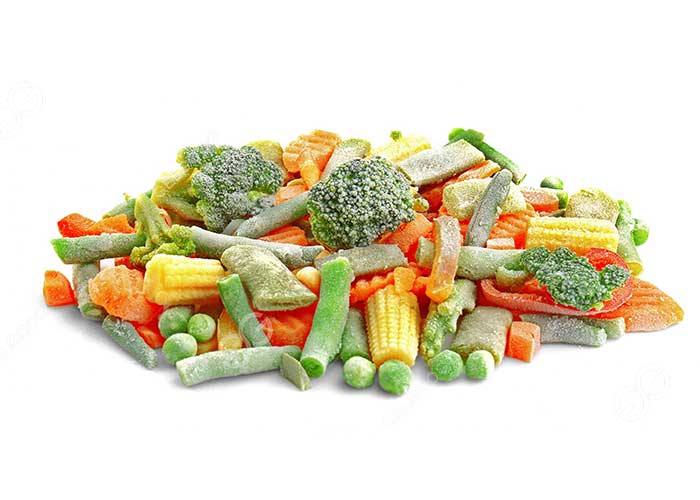Frozen vegetables are an advanced technology to keep vegetables from losing nutrients today. Many people think that vegetables lose their original nutrients when they are frozen, but research shows that. This is not the case, and its original nutritional value will not disappear. Therefore, frozen vegetables have become the mainstream of vegetable processing. Frozen vegetables can not only maintain their original value, but also facilitate storage and transportation. So how are frozen vegetables processed for new business, this article explains it for you.
Processing Technology Of Frozen Vegetables
Raw materials → washing → blanching → cooling → IQF freezing → packaging → refrigeration
1. The quality of raw materials is the most important condition related to the quality of quick-frozen vegetable products. What directly affects the quality of quick-frozen vegetable products is the type and quality of vegetables. In addition, picking period, picking method, climatic conditions, pests, pesticide pollution and optimal maturity are all important factors affecting the initial quality. When selecting raw materials, the size, shape and appearance should be observed, and vegetable varieties with bright color, strong smell, good tissue characteristics and uniform appearance should be selected.
The types of vegetables suitable for IQF freezing are: green peas, kidney beans (beans, lentils), broad beans, edamame, green beans, snow peas, cauliflower, spinach, mushrooms, taro, potatoes, carrots, asparagus, garlic sprouts, green peppers, stems Broccoli, lotus root, sweet potato, etc.

2. Cleaning: The surface of vegetables is stained with sediment, dust and pesticides, especially the surface of root vegetables and the roots of leafy vegetables with a lot of soil, so you should pay attention to cleaning. Quick-frozen vegetables are generally not washed when eaten, and are directly heated for cooking.
3. Blanching: Vegetables have the following functions after blanching. First, destroy the activity of enzymes, stabilize color, improve flavor and texture. Second, kill part of the microorganisms attached to vegetables, reduce the total number of bacteria and bacterial contamination. Third, remove the air in the vegetable tissue to reduce the oxidation of vegetables in the process of storage.
4. Quick-freezing: use vegetable freezing machinery to freeze vegetables. Most vegetables start to freeze at a temperature of about -1°C. When the temperature continues to drop to about -5°C, 70 to 80% of their moisture freezes, and the vegetables become hard.
5. Packaging: Frozen vegetables can be weighed and packaged to facilitate later transportation and sales. It can be sold in different weights according to market demand.
6. Refrigeration: In order to prevent frozen vegetables from melting, refrigeration is generally adopted for later storage, and the frozen vegetables are stored.
The above is an introduction to the operation of how to process frozen vegetables. Of course, if the frozen processing of vegetables is really realized, it needs to be realized by the frozen vegetable processing line. The frozen vegetable processing production line can not only improve the efficiency of vegetable processing, but also reduce the waste of labor and time costs. If you are interested in starting a frozen vegetable processing business, you can contact us, we are a supplier of frozen processing equipment, and we can provide frozen vegetable processing solutions.
